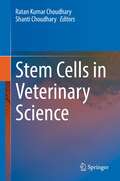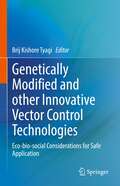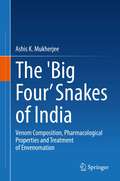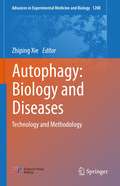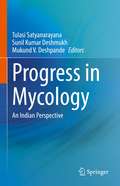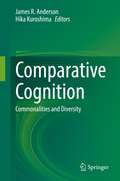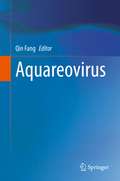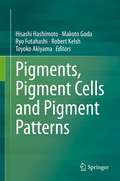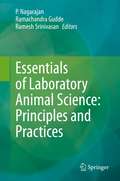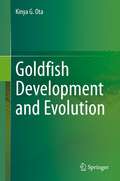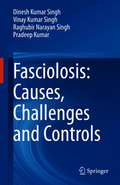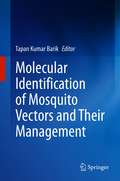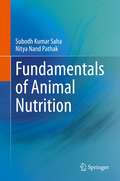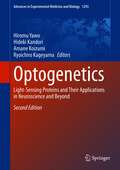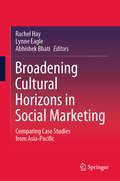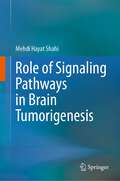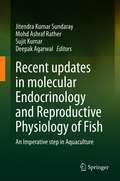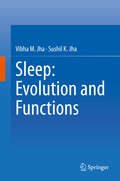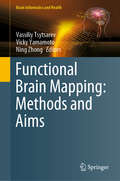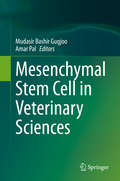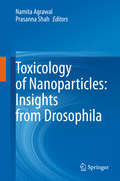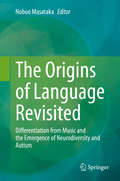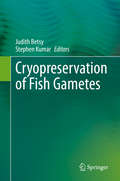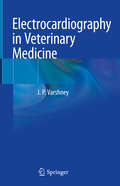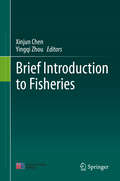- Table View
- List View
Stem Cells in Veterinary Science
by Ratan Kumar Choudhary Shanti ChoudharyThis book explores the potential applications of animal stem cells in veterinary medicine. It begins with an overview of stem cells and their application in treating various animal diseases, including mastitis. In turn, the book discusses the challenges of using stem cells in regenerative medicine and emphasizes the importance of understanding the action of stem cells and preclinical evidence for ensuring safety and therapeutic efficacy. It also presents methods for the identification, characterization, and quantification of stem cells. Further, it discusses the therapeutic applications of different stem cells, including milk-derived, testicular, and mesenchymal stem cells in veterinary medicine. Lastly, it discusses strategies for and therapeutic applications of genome editing by CRISPER/Cas9 in mammary stem cells. As such, the book offers a valuable resource for students and scientists working in the veterinary sciences and veterinarians.
Genetically Modified and other Innovative Vector Control Technologies: Eco-bio-social Considerations for Safe Application
by Brij Kishore TyagiThis book comprehensively covers the latest development in developing and deploying the genetically modified vectors, particularly Anopheles and Aedes mosquitoes responsible for transmitting malaria parasites and dengue viruses, the most deadly and/or debilitating among all the vector-borne diseases. It is considered timely and commensurate to bring about a book dealing with the various ecological, biological and social as well as regulatory aspects for the deployment of genetically modified vectors in special context with the biosafety of humans, his associates, and the environment. Written by an array of specialists and experts in various subjects of genetically modified organisms, this book centrally addresses the (i) basic principles of the genetic manipulation of vectors and they are potential impact on human and the environment, (ii) ecological, biological, ethical, legal and social implications of the use of genetically modified vectors, (iii) identification of potential hazards; assessment and management of risks for human and environment; risk/benefit analysis, (iv) principles and practices for the assessment and management of biosecurity and biosafety in laboratories (and in the field), (v) guiding principles for creation and management of institutional or national biosafety review boards and ethics review committees, and (vi) development and application of a biosafety regulatory framework and its related legal principles at national levels for securing the development and use of vector control methods based on genetic modification strategies. This publication will be useful to researchers, scientists, and professionals engaged in academic and research institutions, government or non-government, as well as students in universities and medical colleges.
The 'Big Four’ Snakes of India: Venom Composition, Pharmacological Properties and Treatment of Envenomation
by Ashis K. MukherjeeThis book provides detailed and updated knowledge about medically important ‘Big Four’ venomous snakes of India (Indian spectacled cobra, Indian common krait, Indian Russell’s viper, and Indian saw-scaled viper). This book essentially covers the snakebite problem in the world with particular reference to Asia and India. It discusses the evolution and systematics of venomous snakes, emphasizing ‘Big Four’ venomous snakes of India; the evolution and composition of venoms determined by traditional biochemical and modern proteomic analyses. It also describes the pharmacological properties of enzymatic and non-enzymatic toxins of ‘Big Four’ venomous snakes of India. Different chapters discuss exciting topics such as species-specific and geographical differences in venom composition and its impact on pathophysiology and clinical manifestations of snakebite envenomation in India, biomedical application of Indian snake venom toxins; production and quality assessment of commercial antivenom, prevention, and treatment of snakebite in India, adverse effects of antivenom including strategies to combat antivenom reactions inpatient.This book caters to toxinologists, pharmacologists, zoologists, antivenom manufacturers, biochemists, clinicians, evolutionary biologists, herpetologists, and informed non-specialists interested to know about the Indian snake venoms.
Autophagy: Technology and Methodology (Advances in Experimental Medicine and Biology #1208)
by Zhiping XieThis book series consists of 3 volumes covering the basic science (Volume 1), clinical science (Volume 2) and the technology and methodology (Volume 3) of autophagy. Volume 3 focuses on the technical aspects of autophagy research. It is comprised of two parts. The first part discusses the basic process of autophagy, including its overall classification and individual stages in the life cycle of autophagosomes. The second part discusses the tools, strategies, and model systems in current autophagy research, including cell and animal models, detection and manipulation methods, as well as screening, genomic, proteomic and bioinformatic approaches. The book is written and edited by a team of active scientists. It is intended as a practical reference resource for interested researchers to get started on autophagy studies.
Progress in Mycology: An Indian Perspective
by Tulasi Satyanarayana Sunil Kumar Deshmukh Mukund V. DeshpandeIndian mycologists have extensively studied various groups of fungi such as soil fungi, aquatic fungi, marine fungi, endophytic fungi, fungi associated with man and animals. Though several books on various aspects of fungi are published, this is the first account of the history and developments in mycology in India. It discusses at length various stages of development of mycology including both classical and biotechnological aspects. It begins with a historical account of Indian mycology, followed by a description of research on fossil fungi. Further chapters cover the latest updates on different taxonomic groups of fungi. A dedicated section describes the roles and applications of fungal endophytes. The book also includes research in other important areas such as mushrooms and wood rotting fungi. Different chapters are written by leading mycologists. This book is useful to students, teachers and researchers in botany, microbiology, biotechnology and life sciences, agriculture and industries using fungi to produce various valuable products.
Comparative Cognition: Commonalities and Diversity
by James R. Anderson Hika KuroshimaThis book presents an overview of selected topics in comparative cognition, which is the study of behaviour and mental activities in nonhuman animals. Human psychological capacities are often used as a heuristic by comparative cognitive scientists, whose tasks include designing valid procedures for studying species’ sensory, linguistic or manipulatory abilities that differ from those of humans. Nonetheless, researchers have developed many original ways to gain insights into how other species perceive the world, store and integrate information, and communicate. The contributors to this book have all been involved in such work, and will present some of the approaches that have led to clear advances in our understanding of cognitive processes in other species. The chapters integrate a review of past literature with recent work, covering a variety of subject species including birds, domestic dogs and cats, and nonhuman primates. All contributors have worked with or been otherwise influenced by Professor Kazuo Fujita, to whom the volume will be dedicated. Fujita’s openness to research on various topics and species is reflected in the diversity of the chapters presented.The book will be of interest to students and more experienced researchers in diverse fields including psychology, anthropology, biology and veterinary studies.
Aquareovirus
by Qin FangAquareoviruses cause infection in bony fish and shellfish and thus, constitute a significant threat to aquaculture industries worldwide. Aquareoviruses, belonging to the family Reoviridae, have genomes consisting of 11 segments of double-stranded RNA contained within a core (T = 1) surrounded by a double-layered icosahedral capsid with a T = 13 symmetry in general. These viruses not only physically resemble mammalian orthoreoviruses, but also show the highest amino acid identity. More than hundred aquareoviruses have been isolated from both saline water and freshwater origins; however, literary sources elucidating aquareovirus biology are very limited. Given the increasing pace of discovery, it is imperative to make a clear, systematic filing of key aspects of aquareoviruses. Therefore, the aim of writing this book is to provide insights into the molecular mechanisms of evolution, pathogenesis, and host response in aquareovirus infection. This book offers a state-of-the-art report on recent discoveries concerning the aquareovirus genome evolution, gene encoded protein functions, and pathogenesis by comparison with its sister genus Orthoreovirus, including avian and mammalian reoviruses. It mainly focuses on advances made over the past 30 years in research on the general and molecular biology, protein structure and function, infection and replication, epidemiology and diagnosis, immunological prevention and medical treatment, and host antiviral immunity against aquareovirus infection. This book will help curious graduate students or interested researchers acquire an overall picture of aquareovirus infection and pathogenesis, as well as yield benefits in fisheries to better prevent and control diseases caused by aquareovirus infection.
Pigments, Pigment Cells and Pigment Patterns
by Hisashi Hashimoto Makoto Goda Ryo Futahashi Robert Kelsh Toyoko AkiyamaThis book comprehensively summarizes the biological mechanisms of coloration and pattern formation of animals at molecular and cellular level, offering up-to-date knowledge derived from remarkable progress in the last 10 years. The brilliant coloration, conspicuous patterns and spectacular color changes displayed by some vertebrates and invertebrates are generally their strategies of the utmost importance for survival. Consists of mainly three parts, starts with introductory chapter, such as Pigments and Pigment Organelles, Developmental Genetics of Pigment Cell Formation, Adult Pigment Patterns, and Color Changes, this book introduces new pigment compounds in addition to classically known pigments and organelles, explains how the generation of multiple types of pigment cell is genetically controlled, describes the mechanisms underlying the zebrafish stripe formation as well as other animals and also summarizes the mechanism of physiological and morphological color changes of teleost, amphibian and cephalopod. Written by experts in the field, this book will be essential reading for graduate students and researchers in biological fields who are interested in pigmentation mechanisms of animals.
Essentials of Laboratory Animal Science: Principles and Practices
by P. Nagarajan Ramachandra Gudde Ramesh SrinivasanThis book comprehensively reviews the anatomy, physiology, genetics and pathology of laboratory animals as well as the principles and practices of using laboratory animals for biomedical research.It covers the design of buildings used for laboratory animals, quality control of laboratory animals, and toxicology, and discusses various animal models used for human diseases. It also highlights aspects, such as handling and restraint and administration of drugs, as well as breeding and feeding of laboratory animals, and provides guidelines for developing meaningful experiments using laboratory animals.Further, the book discusses various alternatives to animal experiments for drug and chemical testing, including their advantages over the current approaches. Lastly, it examines the potential effect of harmful pathogens on the physiology of laboratory animals and discusses the state of art in in vivo imaging techniques.The book is a useful resource for research scientists, laboratory animal veterinarians, and students of laboratory animal medicine.
Goldfish Development and Evolution
by Kinya G. OtaThis book explains how the beautiful goldfish body develops from a single fertilized egg and how this developmental process was changed during the process of domestication. The contents can be categorized as follows: i) numerous high-quality live photo images of embryonic and larval stage goldfish, ii) detailed descriptions of skeletogenesis with fluorescent microscopic and histological images, iii) the most advanced interpretation of the relationship between artificial selection and developmental processes, iv) future perspectives of the application of the genome editing techniques for the ornamental goldfish breeding, and v) methodological descriptions for goldfish developmental biology. Goldfish is a popular ornamental domesticated fish species, and its highly diverged morphological features and color variations attract fanciers. The goldfish has been spread all over the world by breeders, and this fish has also been employed as an experimental organism by researchers in the field of life science. However, so far, no available scientific books provide a detailed description of the embryogenesis and morphogenesis of this animal. Compared with the number of published fancier books, the number of books on goldfish biology is very few. This publication will be useful not only for the research community particularly in the fields of developmental biology, evolutionary biology, zoology, aquaculture, fishery science, and related areas but also for enthusiastic goldfish fanciers and breeders.
Fasciolosis: Causes, Challenges and Controls
by Dinesh Kumar Singh Vinay Kumar Singh Raghubir Narayan Singh Pradeep KumarThis book provides an up-to-date review of fasciolosis, a disease caused by Fasciola hepatica and Fasciola gigantica, including its biology, transmission, epidemiology, host distribution, economic impact, and novel approaches for its diagnosis, treatment and prevention.It first offers a brief overview of the history of the disease, the genetic diversity of the parasite and its distribution, and the ecology of the vector snail, which belongs to the Lymnaeidae/Planorbidae family. It also examines the current strategies and novel approaches for controlling the parasite, diagnosing infections and vaccine development.Importantly, it highlights issues relating to the control of fasciolosis, including drug resistance, lack of effective diagnostics, and the parasite’s long-term survival strategies based on regulation and modulation of the host immune system. Lastly, it discusses the novel control snail vectors using bait formulations, and synergetic and phototherapy treatment with chlorophyllin, which does not kill the vector.
Molecular Identification of Mosquito Vectors and Their Management
by Tapan Kumar BarikThis book summarizes the recent advancements in identifying the mosquito vectors and discusses various strategies for their control. The book describes various molecular taxonomic methods, including DNA barcoding and single nucleotide polymorphism-based machine learning approach, which are used for the identification of mosquito vectors. It also presents the various mosquito control methods, namely, phytochemicals, Bacillus thuringiensis toxins, nanotechnology, biological control agents, and environmental management strategies. It also highlights the importance of various repellents that are used for protection from different kinds of mosquito vectors. Finally, the book offers a comprehensive yet representative description of challenges associated with mosquito vector-borne diseases. The book is a useful resource for medical entomologists, health workers, and researchers working in mosquito-control and vector-borne diseases.
Fundamentals of Animal Nutrition
by Subodh Kumar Saha Nitya Nand PathakThe book provides comprehensive information about the different aspects of veterinary nutrition in tropical countries.The introductory chapter discuss the importance of nutrition, feeds and feeding of balanced and optimum feeds specifically required for the sustenance of life. The second chapter, discusses briefly the history of research in animal nutrition.The book further talks about the relationship between the environment and nutrition in animals; the chemical composition of plants and animals; and the various sources of feed for animals. It provides details on the different phases of life cycle in animals, and the effect of nutrition on the performance. Various Nutrients and its importance in livestock nutritionand production has been illustrated in details. Various nutrients such as water, carbohydrate, protein, fats, vitamins, minerals etc are individually dealt in a separate chapter. The digestive system,digestion and metabolism of carbohydrates, protein and fats in ruminant and non ruminant livestock have been illustrated. A dedicated chapter fully describes the activity of enzymes which are directly involved in nutrition. Also this book deals with the harmful components of animal feed which are found mainly in the unconventional feeds. The books also provide chapters like partitioning of feed& energy and also the therapeutic and clinical nutrition which are very importantfor the under graduate & post graduate students and researchers of animal nutrition and livestock production and management. This book is useful for researchers, undergraduate and post graduate students studying veterinary sciences, animal husbandry, zoology and biochemistry.
Optogenetics: Light-Sensing Proteins and Their Applications in Neuroscience and Beyond (Advances in Experimental Medicine and Biology #1293)
by Hiromu Yawo Hideki Kandori Amane Koizumi Ryoichiro KageyamaThis book, now in a thoroughly revised second edition, offers a comprehensive review of the rapidly growing field of optogenetics, in which light-sensing proteins are genetically engineered into cells in order to acquire information on cellular physiology in optical form or to enable control of specific network in the brain upon activation by light. Light-sensing proteins of various living organisms are now available to be exogenously expressed in neurons and other target cells both in vivo and in vitro. Cellular functions can thus be manipulated or probed by light. The new edition documents fully the extensive progress since publication of the first edition to provide an up-to-date overview of the physical, chemical, and biological properties of light-sensing proteins and their application in biological systems, particularly in neuroscience but also in medicine and the optical sciences. Underlying principles are explained and detailed information provided on a wide range of optogenetic tools for the observation and control of cellular signaling and physiology, gene targeting technologies, and optical methods for biological applications. In presenting the current status of optogenetics and emerging directions, this milestone publication will be a “must read” for all involved in research in any way related to optogenetics.
Broadening Cultural Horizons in Social Marketing: Comparing Case Studies from Asia-Pacific
by Rachel Hay Lynne Eagle Abhishek BhatiThis book presents a series of empirically based case studies conducted by social change scholars from Asia-Pacific, showcasing the latest social marketing approaches geared at improving societal well-being in the region. Cutting across cultural perspectives, the contents gather ideas on social marketing campaigns and strategies from around the region and use these case studies as a platform to address concomitant challenges in employing marketing tools to positively change social behaviour. The selection of case studies covers and compares aspects of public health and well-being, and public environmental consciousness in terms of driving attitudes towards implementing improved sustainability in developing and developed countries. Drawing on related policies and legislation, and examining social behaviour at the individual, community, and organisational levels, the authors propose innovative new methods in social marketing and social change research. The book is of interest to researchers and practitioners in social marketing, business ethics, behavioural science, public health, and development studies.
Role of Signaling Pathways in Brain Tumorigenesis
by Mehdi Hayat ShahiThis book provides acomprehensive overview of cell signalling pathways and morphogens in the genesis of brain tumours. It also explains the role of brain tumour stem cells in the brain tumour progression. It also elucidates the novel early biomarkers that can be utilized to diagnose brain tumours. It presents the basic developmental pathways and morphogens, including retinoic acid and TGF-b that promote brain tumorigenesis. The chapters illustrate the role of stem cells and stem cells mediated cell signalling pathways including, Sonic hedgehog, Notch, Wnt in the brain tumour growth. The chapters also emphasize the role of transcription factors, mainlyNanog, Sox, BMI1, HIF1 and Pax6 in the brain tumouriogensis. It highlights the role of NF-kb, Myc and neurotrophins in the brain tumour development. Finally, the book summarizes the potential early therapeutic targets and targeted drug discovery for brain tumours.
Recent updates in molecular Endocrinology and Reproductive Physiology of Fish: An Imperative step in Aquaculture
by Jitendra Kumar Sundaray Mohd Ashraf Rather Sujit Kumar Deepak AgarwalThis book is dedicated to present different aspects of reproductive physiology and molecular endocrinology of commercially important as well as potential aquaculture fish species. The existing aquaculture generation is looking for species diversification for efficient utilization of available diverse water resources. The knowledge of reproductive physiology of fish will help in development of breeding strategy for use in commercial aquaculture. Reproductive system is highly coordinated and governed by means of complex network of nervous, endocrine system and environmental factor as well. This book emphasize on different key aspects of reproductive endocrine system such as basic gonadal biology in the events of climate vulnerability, sex determination, sex reversal, stimulatory hormones, inhibitory hormones and receptors, environmental and chemical factor guiding reproduction, puberty, neuroendocrine regulation of reproduction etc. This book further describes how reproduction is not just indispensable for the existence or survival of an individual, but it is important for the survival of species. Chapters also address the concerns of anthropogenic activities on fish and the aquatic environment lead main trouble on physiological and reproductive processes of aquatic animals.This book offers an attractive compilation of highly relevant aspects of current and future of aquaculture, especially in view of the growing awareness of aquaculture, to food scientists working on commercial fish, animal biologists, fish geneticists etc. This book is very timely, and relevant to the sustainable development goals. The contents would be relevant to policy makers, working towards blue revolution and blue economy.
Sleep: Evolution and Functions
by Vibha M. Jha Sushil K. JhaThis book discusses the evolution of sleep and its possible function in the higher invertebrates and vertebrates, including humans. It describes the current concept of sleep and its functions, based on research on the mammalian system. To date, electrophysiological recordings of the brain waves, muscle activity, and eye movements are the only tools available for characterizing the sleep architecture in the majority of animals. In mammals and birds, only two distinct types of sleep are found – non-rapid eye movement (NREM) and rapid eye movement (REM) sleep. Since the discovery of REM sleep, studies have been performed to understand the purpose of the two distinct sleep states in higher vertebrates (birds and mammals), and how REM sleep was evolved. The book summarizes the role of both REM and NREM sleep in the proper functioning of the brain and body. It covers various aspects of the role of sleep in important physiological processes, including memory consolidation, induction of synaptic plasticity, energy restoration, enhancing immune response, and maturation of neuronal circuitries during early life. Lastly, the book reviews the effects of chronic/acute sleep deprivation on memory consolidation, obesity, and the immune system in animal models and humans.
Functional Brain Mapping: Methods and Aims (Brain Informatics and Health)
by Vassiliy Tsytsarev Vicky Yamamoto Ning ZhongThis book provides an essential overview of the broad range of functional brain imaging techniques, as well as neuroscientific methods suitable for various scientific tasks in fundamental and clinical neuroscience. It also shares information on novel methods in computational neuroscience, mathematical algorithms, image processing, and applications to neuroscience.The mammalian brain is a huge and complex network that consists of billions of neural and glial cells. Decoding how information is represented and processed by this neural network requires the ability to monitor the dynamics of large numbers of neurons at high temporal and spatial resolution over a large part of the brain. Functional brain optical imaging has seen more than thirty years of intensive development. Current light-using methods provide good sensitivity to functional changes through intrinsic contrast and are rapidly exploiting the growing availability of exogenous fluorescence probes. In addition, various types of functional brain optical imaging are now being used to reveal the brain’s microanatomy and physiology.
Mesenchymal Stem Cell in Veterinary Sciences
by Mudasir Bashir Gugjoo Amar PalThis book focuses on mesenchymal stem cells (MSCs) of animal origin, including their isolation, characterization, and clinical applications. After briefly discussing the historical development of the field of stem cell research, it describes the basic properties and nature of stem cells particularly in relation to MSCs. In turn, it reviews materials and methods used to isolate MSCs from various sources, culture expansion, characterization and long-term storage. It also explores the therapeutic efficacy, immunomodulation and anti-inflammatory, and differentiation properties of MSCs. Importantly, the book discusses the applications of genetic engineering to enhance the efficacy and potential of MSCs in regenerative medicine. The book largely addresses the potential applications of mesenchymal stem cells in therapies for important species of domesticated animals including sheep, goats, cattle, buffalo, cats, dogs and horses. Finally, the book presents an abridgement of challenges and future prospects of stem cell research and application in medicine, in general and veterinary sciences, in particular.
Toxicology of Nanoparticles: Insights from Drosophila
by Namita Agrawal Prasanna ShahThis book offers an unparalleled source of information on in vivo assessment of nanoparticle toxicity by using Drosophila as a model organism. Nanoparticles have emerged as an useful tool for wide variety of biomedical, cosmetics, and industrial applications. However, our understanding of nanomaterial-mediated toxicity under in vivo condition remains limited. The book begins with a chapter on synthesis and characterization of nanoparticles used for various biological, medical and commercial purposes. The rest of the chapters deal with the impact of nanoparticles on different biological aspects like behavior, physiology and metabolic homoeostasis using Drosophila as a model organism. Lastly, the book summarizes how proper characterization and evaluation of safe dosage of nanoparticles can be a boon if incorporated in consumer goods and for biomedical applications.Overall, the book pursues an interdisciplinary approach by connecting nanotechnology and biology from various angles using Drosophila as a model system, so as to develop more efficient, safe and effective use of nanoparticles for human beings.
The Origins of Language Revisited: Differentiation from Music and the Emergence of Neurodiversity and Autism
by Nobuo MasatakaThis book summarizes the latest research on the origins of language, with a focus on the process of evolution and differentiation of language. It provides an update on the earlier successful book, “The Origins of Language” edited by Nobuo Masataka and published in 2008, with new content on emerging topics.Drawing on the empirical evidence in each respective chapter, the editor presents a coherent account of how language evolved, how music differentiated from language, and how humans finally became neurodivergent as a species. Chapters on nonhuman primate communication reveal that the evolution of language required the neural rewiring of circuits that controlled vocalization. Language contributed not only to the differentiation of our conceptual ability but also to the differentiation of psychic functions of concepts, emotion, and behavior. It is noteworthy that a rudimentary form of syntax (regularity of call sequences) has emerged in nonhuman primates. The following chapters explain how music differentiated from language, whereas the pre-linguistic system, or the “prosodic protolanguage,” in nonhuman primates provided a precursor for both language and music. Readers will gain a new understanding of music as a rudimentary form of language that has been discarded in the course of evolution and its role in restoring the primordial synthesis in the human psyche. The discussion leads to an inspiring insight into autism and neurodiversity in humans. This thought-provoking and carefully presented book will appeal to a wide range of readers in linguistics, psychology, phonology, biology, anthropology and music.
Cryopreservation of Fish Gametes
by Judith Betsy Stephen KumarUnderstanding the reproductive physiology and endocrinology of fishes is essential for captive maturation and seed production in the field of aquaculture. Studying the spermatology of fishes is a comparatively new focus in aquaculture, which has emerged as an important area of fish research over the past two decades. In this regard, the cryopreservation of fish gametes is a crucial aspect. Moreover, energetics studies of gametes have become essential, considering the loss of vigour in the spermatozoa after cryopreservation.The latest development in this context is the cryopreservation of spermatogonial stem cell, which is also covered in the book, along with detailed information on embryo cryopreservation in fishes and crustaceans. The role of cryopreservation in conservation programmes is another important aspect, one that will especially interest biologists.This book addresses central issues in fish gamete cryopreservation and breeding, while also reviewing the history of cryopreservation. Its most unique feature is the breadth of its coverage, from basic information on reproduction in fishes, to such advanced topics as embryo cryopreservation. Chiefly intended as a handy troubleshooting guide, the book represents a valuable resource for research students in related fields.
Electrocardiography in Veterinary Medicine
by J.P. VarshneyThis book provides essential information on methodologies for recording electrocardiograms in various animal species, including dogs, cats, cattle, buffaloes, sheep, goats, mithun, chelonians, snakes, avians, equines, rabbits, and the Indian gray mongoose. It also reviews the electrocardiographic physiology, generation of electrocardiograms, and normal criteria for various animal species; electrocardiograms in health and disease; and the interpretation of abnormal electrocardiograms, cardiomyopathy and arrhythmias, with corresponding treatment protocols.Further, it presents several approaches to interpreting the electrocardiograms of dogs, cats, ruminants, tortoises, pigeons, and other animals, offering a valuable resource for all veterinary students, scientists, and physicians wanting to make greater use of this valuable non-invasive tool in the diagnosis of heart diseases and general health examinations.
Brief Introduction to Fisheries
by Xinjun Chen Yingqi ZhouThis book offers an introduction to aquaculture sciences and fisheries, discussing the concepts and basic characteristics of fisheries, fishery resources and the related industries, as well as the status of fisheries in various countries around the globe. The book also examines aquaculture, aquatic product processing and utilization, fishery information technology, and fishery economics and management, in addition to hot topics such as blue growth in fisheries, carbon sink fisheries, and global environmental changes in the context of fisheries. Given its scope, it is a valuable resource for undergraduate students in the field as well professional requiring a basic understanding of fisheries.
